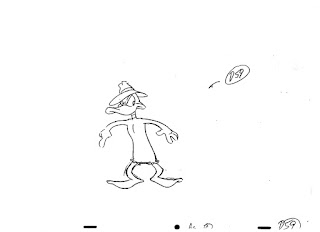The Bouncing Ball exercise uses the animation principles known as:
- Arcs
- Ease Ins and Outs
- Squash and Stretch
Here is a link about setting up an animation scene.
For the bouncing ball exercise, we need a path of motion and the Key poses of your Ball. Keep in mind, the smaller the ball size, the more balls you will be drawing. Keep the ball the same size throughout the scene.
Layout the Scene: Define the Field of view, say a 10 Field.
1)
Start with a 10 field size and determine the horizon line. Figure out
the Arcs on the Ball's motion path. The Ball will follow the Line of
Action.
Horizon Line is your Background layer or BG. on separate paper.
Put your Line of Action on a separate paper (Layer 1)
Make sure the Line of Action does not have the ball landing on the Horizon line. Keep Ball landing below it to help create dimension.
Add Key Poses of the Ball to your the Path of Action! (Layer 1)
Breakdowns are the half way drawings between your Key Poses.
As you are setting up these Key drawings, you want the ball to fall and pop up faster by using less drawings and more spacing between those drawings.
When the Ball Arcs upward and the down, the Ball should slow down, more overlapping drawings or less spacing between those drawings.
After
the Breakdowns are in place, you can add the inbetweens. Here you can
see the animation Spacing and Ease In and Outs in one drawing. To save
your sanity for later, Trace your Key Poses and Breakdowns on separate
sheets of paper and then
add your inbetweens one piece of paper at a time.
You
can then add those Squash and Stretch drawings when the Ball is about
to hit the ground (Stretch), hits the ground (Squash) and then Recoils
upward (Stretch).
Noticed
that the Squash position is the most extreme on the first hit, the Ball
looses energy and on the second Arcs up less then the first Arc.
Students always Squash the Ball the same throughout the scene, which
looks odd because the Arcs are getting smaller, but the Squash poses are
all the same.
This
occurs with the Stretch poses as well, notice above how the first
Stretch pose is more extreme than the other Stretch poses. The Ball is
loosing energy and speed, and so less Stretch is needed.
Squash
and Stretch are used to exaggerate a drawing to speed up or slow down
motion or how an object in motion reacts when it hits something. In real
life, Squash and Stretch happens very quickly and can be seen with high
speed photography.
Watch the Tennis and Golf ball below to see the squash and stretch.
Even a hard surfaced Golf ball squashes and stretches.
Squash
and Stretch helps the audience understand what the ball is made of. The
more squash and stretch, the more rubbery the ball will appear.
Be
sure to keep your Squash and Stretch poses with the same volume as the
original Ball. If the SS poses are too small or big, it will look odd.
Here's the Bouncing Ball...
Wait! Wait!! What about Weight?
Can you draw two Ball drawings of the same size, but show the audience they have different weight?
By using spacing and timing as well as Squash/Stretch, you can show the differences in a lightweight ball and a Heavy ball bounce side by side. The Lite weight ball is more bouncy with more squash and stretch, while the Heavy ball falls faster and has less bounce, with no squash/stretch. Even a heavy bowling ball will have a slight bounce and vibrate to an abrupt stop.
Always test, revise your drawings and reshoot your work. Use your exposure sheet to write down the final timing for the final animation.






















